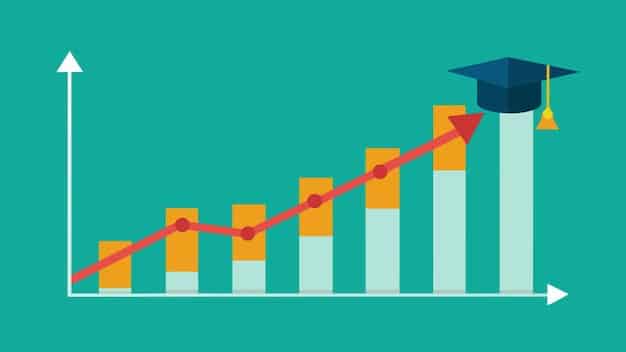Prioritize Debt: Your Step-by-Step Financial Stability Guide

Prioritizing your debts is crucial for achieving financial stability; this guide provides a structured approach to identify and manage high-priority debts like secured loans and tax obligations, while offering strategies to handle lower-priority debts effectively.
Feeling overwhelmed by mounting debt? This comprehensive guide, How to Prioritize Your Debts: A Step-by-Step Guide to Financial Stability, will provide you with a clear roadmap to regain control of your finances and work towards a more secure future.
Understanding Debt Prioritization
Debt prioritization involves strategically organizing your debts based on factors like interest rates, consequences of non-payment, and the impact on your overall financial well-being. It’s not just about paying off the biggest debt first; it’s about tackling the debts that pose the greatest risk to your financial stability.
Effectively prioritizing your debts can provide relief from immediate financial stressors and set the stage for long-term financial health. Let’s explore how this works.
Why Prioritize Your Debts?
Prioritizing your debts may seem like common sense, but many people simply pay bills as they come, without a strategic approach.
- Avoid Severe Consequences: Prioritization can help you avoid dire consequences like foreclosure, repossession, or legal action.
- Reduce Stress: A clear plan reduces anxiety related to managing multiple debts.
- Save Money on Interest: Focusing on high-interest debts saves you money in the long run.
- Improve Credit Score: Consistent payments on prioritized debts can positively impact your credit score.
Understanding the benefits of prioritizing debts makes the whole process more motivating.

Step 1: List All Your Debts
The first step to prioritizing your debts is to create a comprehensive list of every debt you owe. This includes credit cards, loans, medical bills, and any other outstanding obligations.
Having a clear list provides a complete picture of your financial situation and serves as the foundation for your prioritization strategy.
Gather Debt Information
Collect information for each debt, including the creditor’s name, account number, outstanding balance, interest rate, and minimum payment. Organize this information in a spreadsheet or a dedicated debt management app. This will make it easier to compare and prioritize debts.
- Credit Cards: Note the APR and any promotional rates.
- Loans: Include the type of loan (e.g., mortgage, auto loan, student loan) and the repayment terms.
- Medical Bills: Verify the amount owed and check for any errors.
Having all of this information in one place helps you see the complete picture.
Step 2: Identify Secured vs. Unsecured Debts
The next step in prioritizing debts is to differentiate between secured and unsecured debts. Secured debts are backed by collateral, while unsecured debts are not.
Understanding this distinction is crucial because secured debts generally carry higher priority due to the risk of losing the associated asset.
Examples of Secured and Unsecured Debts
Secured debts often include mortgages, auto loans, and secured credit cards. Unsecured debts include credit card debt, medical bills, and personal loans.
- Secured Debts: Mortgage (backed by your home), Auto Loan (backed by your car).
- Unsecured Debts: Credit Cards, Medical Bills, Personal Loans.
Understanding the difference between types of debt is key to managing them effectively.
Step 3: Prioritize High-Priority Debts
High-priority debts should be addressed first to prevent significant financial repercussions. These debts often include secured debts and those with legal ramifications for non-payment.
Addressing these debts immediately protects your assets and ensures compliance with legal obligations, like taxes.
Examples of High-Priority Debts
Mortgage, auto loan, tax debts, and debts with court orders typically fall into the high-priority category.
- Mortgage/Rent: Failure to pay can lead to eviction or foreclosure.
- Auto Loan: Non-payment can result in repossession of your vehicle.
- Tax Debts: Unpaid taxes can lead to penalties, liens, or even legal action.
- Debts with Court Orders: Legal judgments require immediate attention.
Prioritizing debts in this way helps you to protect yourself and your family.

Step 4: Tackle High-Interest Debts
After addressing high-priority debts, focus on debts with the highest interest rates. These debts can quickly accumulate additional charges, making them harder to pay off over time.
Paying down high-interest debt can save you significant money in the long run, minimizing the total amount you pay on those debts.
Strategies for High-Interest Debts
Consider using debt avalanche or debt snowball methods. The debt avalanche method targets debts with the highest interest rates first, while the debt snowball method focuses on paying off the smallest balances first, regardless of interest rate.
Many people prefer the debt avalanche method for its efficient long-term savings. Here’s more detail on some options:
- Debt Avalanche: Pay minimum on all debts, then put any extra money toward the debt with the highest interest rate.
- Debt Snowball: List your debts from smallest to largest. Pay the minimum on all debts except the smallest, and put any extra money toward that smallest debt. Once that’s paid off, roll the money you were paying on it into the next-smallest debt.
- Balance Transfer: Transfer high-interest credit card balances to a card with a lower or 0% interest rate.
Each method has its advantages, so choose the one that best fits your personality and financial situation.
Step 5: Manage Lower-Priority Debts
Once you’ve addressed high-priority and high-interest debts, turn your attention to lower-priority debts. This typically includes unsecured debts with lower interest rates and less severe consequences for non-payment.
This doesn’t mean ignoring these debts. Setting up a manageable payment plan can help prevent them from becoming overwhelming.
Strategies for Lower-Priority Debts
Negotiate with creditors to lower interest rates or set up a payment plan that fits your budget. Also, consider debt consolidation or debt management programs.
- Negotiate with Creditors: Contact creditors to negotiate lower interest rates or extended payment plans.
- Debt Consolidation: Combine multiple debts into a single loan with a potentially lower interest rate.
- Debt Management Programs: Work with a credit counseling agency to develop a debt management plan.
Proper management of these debts helps consolidate your financial control.
Step 6: Create a Budget and Stick to It
Creating a budget is crucial for successful debt prioritization. Track your income and expenses to identify areas where you can cut back and allocate more funds towards debt repayment.
A well-structured budget helps you see where your money is going and provides a framework for making informed financial decisions.
Tips for Creating a Budget
Use budgeting apps or spreadsheets to track your income and expenses. Identify non-essential spending and allocate those funds towards debt repayment. Regularly review and adjust your budget as needed.
- Track Your Spending: Use a budgeting app or spreadsheet to monitor your income and expenses.
- Identify Non-Essential Expenses: Look for areas where you can cut back on spending.
- Regularly Review and Adjust: Your budget should be a living document that adapts to your changing financial situation.
A budget is the foundation of sound financial management.
| Key Point | Brief Description |
|---|---|
| 📝 List All Debts | Create a comprehensive list with balances, interest rates, and minimum payments. |
| 🛡️ Secured vs. Unsecured | Distinguish between secured and unsecured debts to prioritize effectively. |
| 💰 High-Interest Debts | Focus on debts with the highest interest rates to save money in the long run. |
| 📈 Create a Budget | Track income/expenses to allocate more funds toward debt repayment. |
Frequently Asked Questions
▼
The best method depends on individual circumstances. The debt avalanche method saves more money, while the debt snowball method provides psychological wins, so choose according to your needs.
▼
Contact your creditors and explain your situation. Ask if they can lower your interest rate or create a more manageable payment plan. Be polite and persistent for the best outcome.
▼
Debt consolidation can be beneficial if you qualify for a lower interest rate. However, be sure to compare the terms and fees to ensure it truly saves you money over the long term.
▼
Not prioritizing debts can lead to severe consequences, such as foreclosure, repossession, legal action, damaged credit score, and increased financial stress over time. A strategic approach is essential.
▼
If you feel overwhelmed, are struggling to make minimum payments, or are facing legal action, consider seeking advice from a credit counselor or financial advisor for personalized guidance.
Conclusion
Prioritizing your debts is a critical step towards achieving financial stability. By understanding the different types of debts, developing a strategic plan, and sticking to a budget, you can regain control of your finances and work towards a more secure future. Start today and take the first step towards financial freedom.





